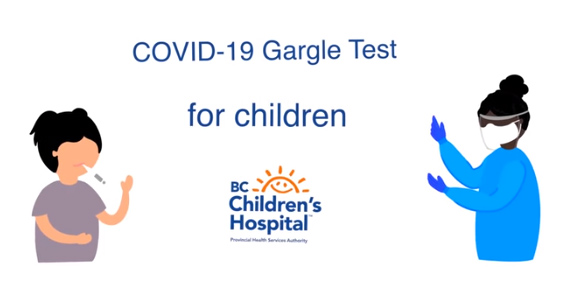
Thursday September 17, 2020 | VICTORIA, BC
by Mary P Brooke, B.Sc., editor | Island Social Trends
“Unfortunately, the COVID-19 pandemic is going to continue now for years into the future,” said Health Minister Adrian Dix today in his livestreamed media availability with Provincial Health Officer Dr Bonnie Henry.
“Through this year and probably through next year, enjoy life with the new normal. It’s going to be with us for a long time,” he said, adding that we will “learn to deal with it together”.
COVID stats September 17:
There are now 7,663 test-positive cases of COVID-19 in BC (115 epi-linked), of which 1,705 are active including 57 people in hospital (down from 60 yesterday, and 63 the day before). Of the people in hospital, 22 are in ICU (similar to yesterday’s 23).
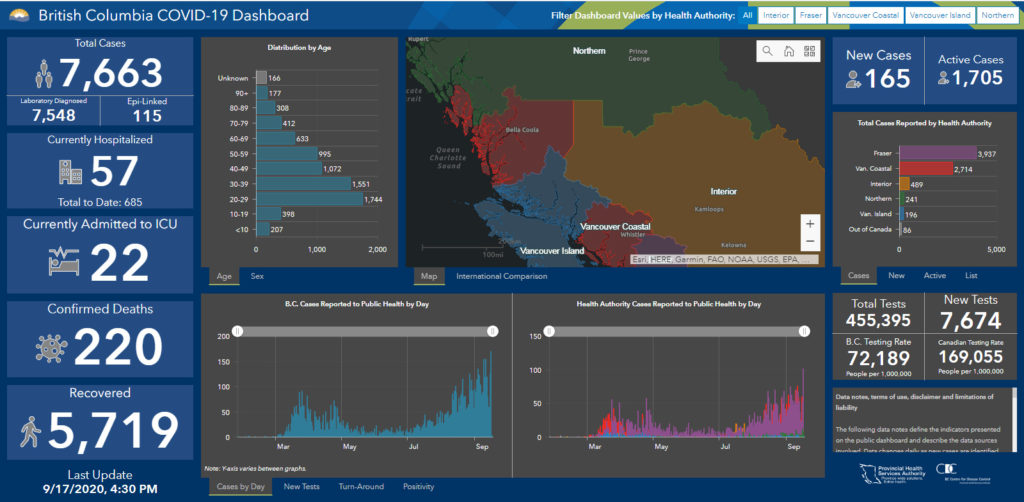
Today’s new case count of 165 is a one-day record. Most days in September the daily case count has been near or over 100.
There was one death from COVID-19 reported today (a man in long-term care in the lower mainland area); to date, 220 people have died from COVID-19 in BC.
Age profile:
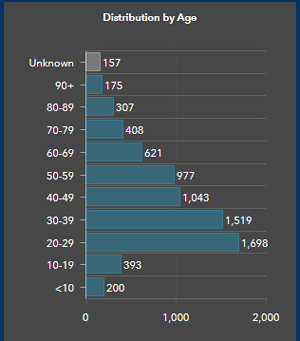
As in the last several weeks, the highest case count increases by age has been in the working-adult age groups, notably 20-29 and 30-39.
Of total cases reported today, the 20 to 39 year ranges together comprise 43% of all COVID-19 cases in BC to date (consist with the past few weeks). Of the 165 new cases reported today, 78 (47.2%) are in people ages 20 to 39 (higher than the last two days).
The 47 cases in the 40-49 and 50-59 age groups together comprise 28.4% of today’s new cases (a jump from 17.2% yesterday).
Seniors of ages 60 to 69 saw 12 new cases over the last 24 hours, and 10 new cases yesterday. This age category — people who are generally still active in the economy — in total consistently comprised 8.3% of all COVID cases in BC for about the last two weeks, but today is down to 7.3%.
Children and youth:
In BC since the pandemic began, a total of 605 people under the age of 19 have tested positive for COVID-19. That’s 207 in ages newborn to 10 years, and 398 in ages 10 to 19.
There has been a slow but steady uptick in cases among children each day during the summer and now also in September.
Saliva test for children:
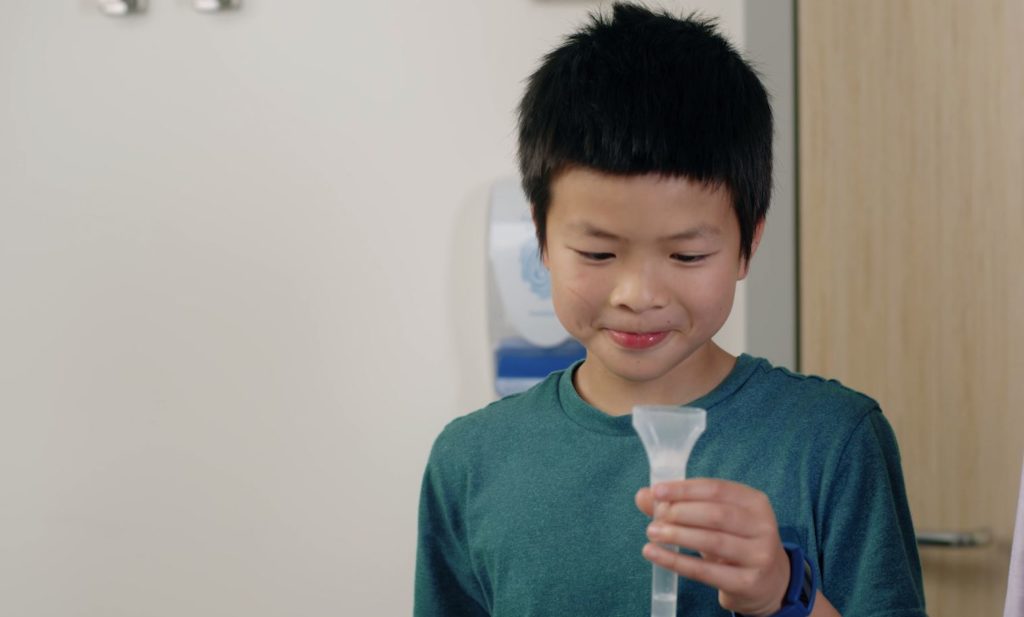
Good news for children and their parents… an easier test for COVID-19! The saliva test only involves gargling a saline solution then spitting it into a collection tube. This collection method will be available for children only so far, given limited preliminary supply of funnel-shaped vials from the local BC manufacturer.
“It’s a collection method not used anywhere else, so products have had to be developed for this,” says Libby Brown, Director of Corporate Communications, Provincial Health Services Authority.
The Public Health Lab at the BC Centre for Disease Control (BC CDC) together with the BC Children’s pathology team developed this new collection method. Both this new method and the nasal swab method are demonstrated in videos for children on the BC CDC website.
“We have as many testing kits as we need for the time being, to test school children and youth from Kindergarten to Grade 12. There is no shortage of ingredients or reagents for this test,” said Brown.
Dr Henry said today that the focus on children with this spit-test because of limited supply, but also the ease of use by parents with children or children alone. As well there is less use of health-care worker time.
Adults who require a COVID-19 test will have to make do with the nasal swab test still for now.
COVID-19 in schools:
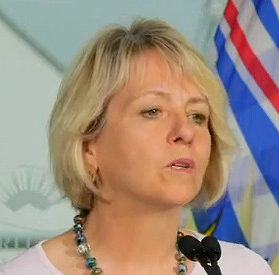
Exposures and outbreaks are expected in schools, says Dr Henry.
School notification pages will be provided on health authority websites. So far, the Fraser Health Authority has launched their school exposures page.
On those pages, parents and others will be able to check for the outbreaks, clusters and exposures for schools in their area.
Public health is ready:
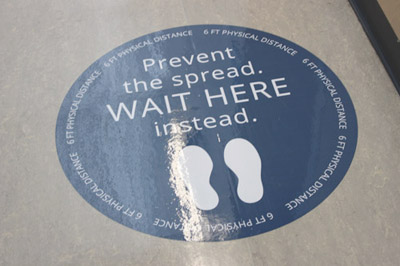
Public health says they are prepared for handling any cases or outbreaks that are likely to occur in schools.
Dr Henry cites how public health has in the past responded efficiently to measles and meningitis in schools.
Smaller bubbles for the long haul:
People are, meanwhile, asked to pull back on social interactions beyond their small bubbles of family and friends, to compensate for exposure to the family through their children in schools.
“Stick to six” is the current phraseology, promoted again today by BC Health Minister Adrian Dix.
If you’re exposed, you’re under watch:
As a result of identified exposure to known cases, 2,966 people are under active public health monitoring. That’s a daily number consistent with the past week or two.
Being under public health surveillance may sound relatively benign. But it means that public health officials are ‘in your face’. They check up daily on symptoms and making sure the people in this group stay isolated.
People exposed to COVID-19 are likely to be missing out on work or school or time with family and friends, with all the associated economic and social impacts.
Hospitalization & recovery:
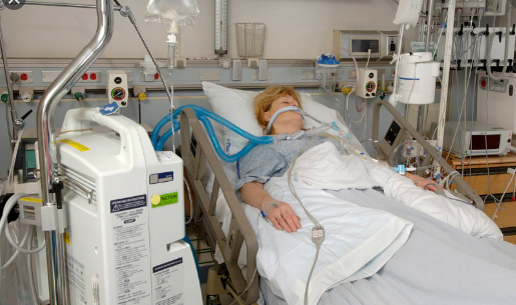
To date, 685 people have been hospitalized with COVID-19 in BC (consistently about 9.0% of total cases). Today 67 people are in hospital (22 of those in intensive care).
Recovery from COVID-19 is tallied at 5,719 people in BC who have tested positive (i.e. 75% of cases, which is fairly consistent with previous days).
Regional COVID impact:
Most COVID-19 cases have occurred and still occur in the Lower Mainland area of BC. A low number of new cases on Vancouver Island occur sporadically (one new case today, in the 40 to 49 year age group).
Vancouver Island COVID-19 profile:
There were 720 COVID-19 tests done within Island Health in the last 24 hours, uncovering one new cases. The total number of cases is now 196 (192 test-positive and 4 epi-linked).
Of the total Vancouver Island cases to date, 180 have recovered. Five people have died on Vancouver Island during the pandemic (no new deaths in many weeks).

Presently 11 people are still active for COVID-19 on Vancouver Island (same as yesterday).





